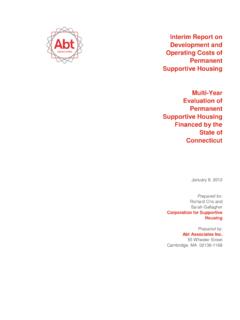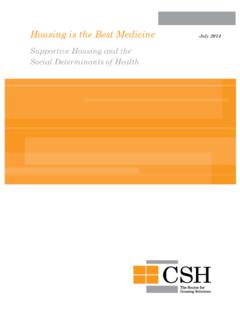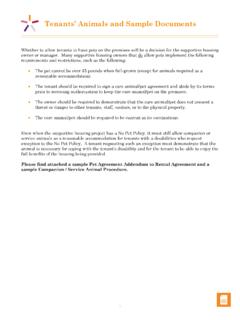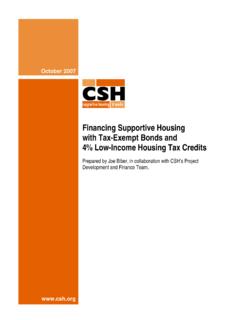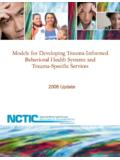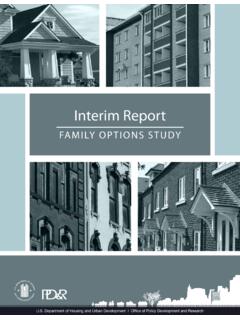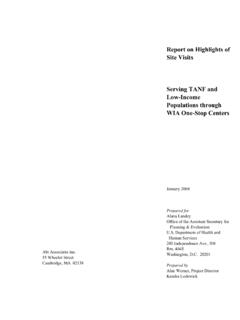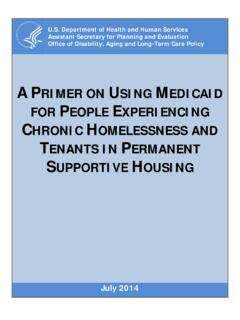Transcription of Interim Report on Tenant and Neighborhood …
1 Interim Report onTenant andNeighborhoodCharacteristics andOccupancyMulti-YearEvaluation ofPermanentSupportive HousingFinanced by theState ofConnecticutJanuary 9, 2012 Prepared for:Richard Cho andSarah GallagherCorporation for SupportiveHousingPrepared by:Abt Associates Wheeler StreetCambridge, MA 02138-1168 AcknowledgementsThe authors of this Report Emily Holt and Gretchen Locke wish to acknowledge the assistanceprovided to this study by a variety of individuals and organizations. We appreciate the guidance andsupport of Richard Cho and Sarah Gallagher of the corporation for supportive housing (CSH), andFran Martin, formerly at CSH. We also thank Steve DiLella at the connecticut Department of MentalHealth and Addiction Services for helping us obtain and interpret the administrative data necessaryfor this study. Equally importantly, we thank the supportive housing providers, property managers,tenants, and community stakeholders who participated in interviews and shared their experiences withthe Abt research team.
2 Their insights greatly enriched this Abt Associates, several staff members played important roles on this study. Dr. Jill Khadduriprovided thoughtful and constructive technical review throughout the study s design and reportwriting. Brooke Spellman also provided helpful guidance and input. Josh Leopold providedprogramming support for the administrative data analysis. Nichole Fiore conducted Tenant andstakeholder interviews. Carissa Climaco prepared the Census data analysis and maps. MissyRobinson produced the Report . We thank them all for their support for the study was provided by the connecticut Department of Mental Health andAddiction Services, connecticut housing Finance Authority, connecticut Office of Policy andManagement, Melville Charitable Trust, Robert Wood Johnson Foundation, Fannie Mae, and theCorporation for supportive also thank the State of connecticut Interagency Committee for supportive housing whichincludes the following State Agencies: The connecticut housing Finance Authority, the StateDepartments of Mental Health and Addiction Services, Department of Social Services, Department ofChildren and Families, Department of Economic and Community Development, Department ofCorrections, the Court Support Services Division of the Judicial Branch and the State Office of Policyand Evaluation of Permanent supportive housing Financed by the State of ConnecticutAbt Associates Inc.
3 Contents pg. iInterim Report on Tenant and Neighborhood Characteristics and Occupancy Final ReportTable of .. of the Evaluation .. on Permanent supportive housing in connecticut .. are the Characteristics of PSH Tenants? .. Profile of PSH Tenants .. Needs Among PSH Living Situation .. of Stay in PSH .. is PSH Located? .. of PSH Neighborhoods .. Profile of PSH Neighborhoods .. Satisfaction with Satisfaction Data Collection .. Satisfaction with PSH Units and Satisfaction with Satisfaction with Their Neighborhoods .. Satisfaction Among Households with Children .. Tenant Satisfaction .. Stakeholders Views of Stakeholder Data Collection .. Perceptions of PSH Neighborhood Quality .. Perceptions of Neighborhood Change .. and 32 Appendix for Selecting Tenants for Tenant Interviews .. 35 Appendix Interview 39 Appendix Stakeholder Interview Guide .. 46 Multi-Year Evaluation of Permanent supportive housing Financed by the State of Contents Abt Associates of ExhibitsExhibit Characteristics of CT PSH Tenants.
4 7 Exhibit at Program 9 Exhibit Living Situation of PSH Tenants Interviewed (N=64).. 10 Exhibit of Stay by Exit Status, Year of Entry .. 11 Exhibit of Stay by Diagnosis at Program 12 Exhibit of Tenant Profile by Development Type .. 14 Exhibit of PSH Development 16 Exhibit of Neighborhood Quality in PSH and non-PSH Neighborhoods, byGeography Type .. 17 Exhibit of Neighborhood Quality in LIHTC, PSH and all ConnecticutNeighborhoods .. 18 Exhibit Satisfaction With PSH housing Units/Buildings .. 21 Exhibit Satisfaction With PSH Property Management .. 22 Exhibit Services Tenants Would Use If Available .. 23 Exhibit with Selected Neighborhood Features .. 25 Exhibit with Neighborhood Features Relevant to Children .. 26 Exhibit Tenants Like About Their Living 27 Exhibit Tenants Dislike About Their Living Situation .. 27 Exhibit Important Thing to Tenants About Where They 28 Exhibit Stakeholders Perceptions of Neighborhood Quality: Number ofRespondents by Neighborhood 30 Exhibit of PSH Developments Selected for Tenant Interviews.
5 36 Exhibit of Interview Respondents by PSH Project .. 37 Exhibit of PSH Neighborhoods Where Interviewed Tenants Lived .. 38 Multi-Year Evaluation of Permanent supportive housing Financed by the State of ConnecticutAbt Associates Inc. Interim Report on Tenant and Neighborhood pg. 1 Characteristics and Occupancy Final of the EvaluationThe State of connecticut has been developing permanent supportive housing (PSH) for homelesspersons with histories of homelessness, mental illness, addiction and other special needs since State has tested and adapted PSH models developed in large cities such as New York City,Chicago and San Francisco for the small and mid-sized cities in connecticut . In general, supportivehousing provides affordable housing linked to services tailored to the needs of each resident,including health, mental health treatment, and substance abuse treatment, as well as other supportiveservices to help tenants maintain stable housing and live as independently as possible.
6 The housing iscalledpermanentbecause it is meant to be longer term where tenants hold their own leases, unlikehousing provided by a shelter or other facility. PSH in connecticut is financed and supported by anintegrated system of public and private sources, including state and federal agencies, local serviceproviders, and non-profit September 2008, the corporation for supportive housing (CSH) engaged Abt Associates Inc, withsubcontractor VIVA Consulting LLC, to undertake a multi-year evaluation of the outcomes and costeffectiveness of connecticut s PSH overarching research questions for the study are: Have connecticut s efforts to develop and operate PSH achieved outcomes that justify theinvestments? Are properties and outcomes sustainable over time? Can the state improve its PSH efforts and/or results with different actions?The study includes a number of data collection activities to support the analysis. The key activitiesare: a review of PSH development and operating costs; assessment of service utilization patterns and costs for participants served in the programs for twoyears before enrollment, for the period of participation, and (if applicable) following exit; and interviews with tenants, developers, housing search providers, project neighbors and othercommunity stakeholders to learn more about program implementation and experience for thesekey stakeholder of This ReportThis Report presents findings on the characteristics of tenants served in PSH and the neighborhoodswhere they live, tenants satisfaction with their housing and their neighborhoods, and localstakeholders perceptions of the quality of PSH and its role in connecticut neighborhoods.
7 Weaddress the following research questions:Multi-Year Evaluation of Permanent supportive housing Financed by the State of Interim Report on Tenant and Neighborhood Abt Associates and Occupancy Final Report What are the characteristics of tenants served in PSH? What are the characteristics of neighborhoods where PSH tenants live? How satisfied are tenants with their housing and neighborhoods? What are other community stakeholders views of PSH quality?The sources of information for this Report include administrative data from state agencies and fromthe US Census, as well as interview data from in-person interviews with PSH tenants and telephoneand in-person interviews with community stakeholders who are familiar with PSH in theircommunities. This Report helps lay the groundwork for the final evaluation Report , which will assessthe service costs and utilization patterns for the tenants we describe here and assess the costeffectiveness of PSH given the costs of developing and operating the Report begins with a brief overview of PSH financed by the state of connecticut and adescription of the methodology for collecting the information presented here.
8 The remaining sectionspresent the findings for each of the research questions noted above. A concluding section summarizesthe implications of the findings and suggestions for future research. Additional information on datacollection methodology is included in Appendix A, and data collection protocols for the resident andstakeholder interviews are include in Appendices B and on Permanent supportive housing in ConnecticutConnecticut s approach to establishing and expanding a stock of supportive housing to meet tenants needs has evolved over time, but has consistently featured an integrated approach to funding capitalcosts, operating expenses, and supportive services. Permanent supportive housing in connecticut hasbeen developed in three phases over more than a decade, using differing funding mechanisms andtargeting priorities. The three phases are: the supportive housing Demonstration Program, theSupportive housing Pilots, and the Next Steps Initiative. This section briefly summarizes the keycharacteristics of the housing options produced and the tenants served in each housing Demonstration ProgramThe supportive housing Demonstration Program, a collaboration of the State of connecticut and theCorporation for supportive housing (CSH), began in 1992 as an effort to address housing issues andservice needs for homeless and at-risk populations.
9 Some 281 units were created through newconstruction or rehabilitation of existing housing in nine developments located in six projects were initially occupied between 1996 and 1998. Funding sources for the housingproduced under the Demonstration included state and federal public sources, as well as privatefunding from CSH, philanthropic organizations, and the National Equity Fund. connecticut sDepartment of Social Services (DSS) and Department of Mental Health and Addiction Services(DMHAS) provided annual service grants for PSH tenants with special more detailed information on the financing and operations of PSH in connecticut , see the followingreport also produced for this research: Interim Report on Development and Operating Costs of PermanentSupportive housing , December Evaluation of Permanent supportive housing Financed by the State of ConnecticutAbt Associates Inc. Interim Report on Tenant and Neighborhood pg. 3 Characteristics and Occupancy Final ReportNonprofit sponsor organizations own the development projects.
10 Sponsors hire property managementcompanies to operate the projects, and nonprofit supportive service providers provide on-site supportto the tenants. To keep rents affordable, DMHAS administers federal rental assistance from theDepartment of housing and Urban Development s (HUD s) Shelter Plus Care program. The ShelterPlus Care program provides grants for rental assistance for people who have been homeless and havemental illness, addictions, or HIV/AIDS. The organization receiving the Shelter Plus Care grant(DMHAS in this case) must provide supportive services at least equaling the dollar value of the Demonstration program tenants are single individuals with incomes below 50 percent of HUD sarea median income. At least 70 percent of each property s units must be occupied by individualswho were formerly homeless or at risk of homelessness and about 50 percent are reserved for peoplewith special needs such as mental illness, chronic substance abuse issues or evaluation was conducted on the Demonstration Program, yielding a series of three reports on keyprogram outcomes, including Tenant service utilization, project financial stability, and patterns inneighborhood property values in PSH housing Pilots InitiativeThe supportive housing Pilots Initiative is also a collaborative effort of state agencies and CSH.
